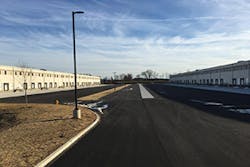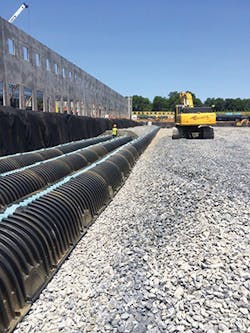Recently, a 58-acre lot in Northampton County, PA, labeled by the town of Easton as First 33 Commerce Center, was developed into a subdivision containing three large land parcels. While two parcels of land were sold off, the third and largest parcel was transformed into a commerce park, housing two state-of-the-art distribution centers. Located directly off Route 33 in Northampton County, the site offers convenient access to both I-78 and I-80, enabling multiple-route connectivity to the New York City metro area, New England markets, and Mid-Atlantic states. UPS, FedEx, and the US Postal Service have freight facilities nearby, providing one- and two-day delivery options to the majority of the United States and Canada. The location was perfect for a distribution center.
The first distribution center, Building A, was designed to host up to 64 loading docks, parking for 141 cars and 75 trailers, approximately 3,250 square feet of office space, and more, giving it a total area of 341,400 square feet. The second, somewhat smaller distribution center Building B, was designed to host up to 57 loading docks, parking for 183 cars, approximately 3,250 square feet of office space, and more, equaling approximately 243,360 square feet. Both distribution centers together bring the total commerce park site area just under 600,000 square feet. Upon completion of the commerce park, the two warehouse buildings will face each other, and loading docks will run the length of the warehouses between the two buildings, with heavy semi-truck trailer traffic expected 24 hours a day, 7 days a week—the projected hours of warehouse operation. Such a large project required a robust stormwater management system, capable of holding up under difficult conditions. Knowing this stormwater system would be a major part of the project’s groundwork, the project team prepared themselves for a lengthy installation process and high labor and equipment costs.
Once the project team had decided on the use of the Cultec stormwater system, the next step was to specify the correct design. After an analysis of the greenspace at the site, it was determined that an infiltration basin was the best approach to stormwater control. With an infiltration basin, the stormwater gathered from a developed site is redirected into chambers and treated, and then “forced” to infiltrate into the soil, recharging the groundwater. Typically, before a site is developed, the water infiltrates naturally into the soil because the area is pervious—made up mostly of vegetation such as grass, brush, trees, and other flora. However, after a site is developed and the area has become impervious due to concrete, gravel, or another barrier, the water no longer infiltrates naturally. Because of this, the project team needs to develop a solution to force that infiltration.
To force infiltration of the stormwater over such a large area, the project designers specified the Cultec Recharger V8HD stormwater chamber. This model could easily provide the required 523,904 cubic feet of storage by using just under 5,000 pieces. The V8HD model measures 32 inches high and 60 inches wide and has an installed length of 7.5 feet and a bare chamber capacity of 8.7 cubic feet per linear foot. The system provides an overall storage of 530,234 cubic feet of combined “active” and “ponding” storage. As a flood prevention measure, the Cultec system has an infiltrative storage of 158,000 cubic feet set below the outlet pipe invert. Infiltrative storage detains the required volume of water for infiltration, controlling the amount of water released to downstream ponds. Instead of releasing downstream, this water is held within Cultec chambers until is infiltrated into the soil. The system provided pond storage of 372,234 cubic feet above the outlet pipe invert. To reach the system requirements, a customized layout was provided. The Cultec technical staff designed the Cultec chamber rows with 12 inches of stone separation and a 3-foot stone border surrounding the entire system. In addition to its storage and infiltration, the V8HD model is able to withstand heavy and constant wheel loads—which was a major requirement because of the operation hours and anticipated traffic of the proposed warehouse facility.
Cultec designer and technical specialist Dan Gera was brought on to this project to facilitate its design. “The key is to create a design that is simple and no different than a smaller project,” says Gera. “We have a large selection of chambers in-house, and we were able to select a chamber that worked perfectly with the height restrictions of the site. Because of this large inventory, we’re able to meet most design challenges that we face.”
Gera selected the V8HD model from Cultec’s arsenal of chambers with the knowledge that this model would meet the volume and footprint requirements of the project without any need to alter the project site—without needing to add stones above or below the chambers, for example. To keep a system as simple as possible, the designer looks to minimize the number of rows used. Cultec chambers are made up of three different types: starters, intermediates, and ends. This allows the designer to start the rows and then run them long, minimizing the number of rows and therefore expediting the installation process itself.
With regard to the installation, lack of storage space on the construction site provided additional challenges for the project’s general contractors. For this reason, contractors expected that the product would need continuous shipments to the site, resulting in significant increased shipping and labor costs. Muschlitz Excavating was called on to facilitate what could have potentially been an exhausting, laborious installation. However, Cultec’s stormwater chambers are easily stacked and stored neatly on pallets, allowing the contractors to bring all the necessary chambers onsite in advance of the installation
—saving time, money, and stockpiling area. Additionally, Muschlitz Excavating general superintendent, Steven Goffredo, had modified an excavator to help move the chambers into position when he first saw the size of the Cultec product, assuming it would be quite heavy.
“We planned on investing substantial time and money into moving the chambers into position,” says Goffredo. “However, due to the lightweight nature of the Cultec product, my team was able to install them by hand; two men could easily take one of the chambers off the stack and put it into position.”
Because of the Cultec stormwater chambers’ ease of installation, The First 33 Commerce Center project was completed months ahead of schedule in the fourth quarter of 2015. This underground stormwater management system is believed to be one of the largest underground stormwater systems in eastern Pennsylvania.








